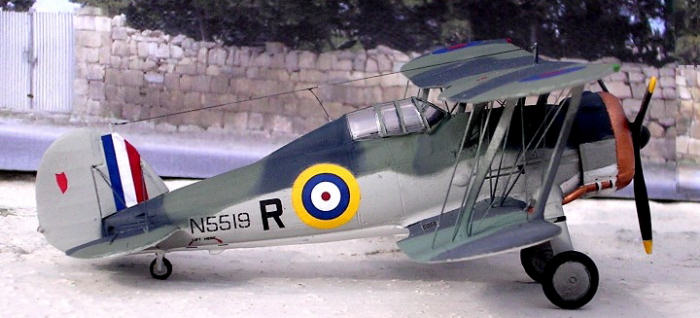
Pavla 1/72 Sea Gladiator
| KIT #: | 72059 |
| PRICE: | 7 Maltese Lire (Around $22.00) |
| DECALS: | options |
| REVIEWER: | Carmel J. Attard |
| NOTES: | Short run with lots of goodies |

| HISTORY |
Back in the beginning of World War Two, when Italy entered the war as from midnight of 10th June 1940, there were in Malta only a handful of Fleet Air Arm biplanes. These were loaned by the admiralty to defend the island from the formidable Reggia Aeronautica. These were the same Sea Gladiators that received tremendous amount of publicity with stories associated with Faith, Hope and Charity and their pilots who flew them continually in the air war operations against overwhelming odds. The destruction of the first enemy aircraft of the war over Malta was an SM 79 Sparviero, which was credited to a Sea Gladiator pilot.
The important position of the Maltese islands, which so
strategically located right in the middle of the Mediterranean Sea, soon reached
another dimension with the rise of Fascist and Nazi regime. From the very early
years prior to the commencement of hostilities the committee for the Imperial
Defense approved the introduction of long-term defense programme for Malta. It
was in March 1940 when measures had to be taken when RAF station at Hal Far
airfield be provided with a station fighter flight and by the following January
Air Commander FH Maynard AOC Malta was informed that apart from the Swordfish
used by No3 Anti-Aircraft Co-operation Unit for torpedo training duties
operating along with a De Havilland Queen Bee radio controlled drone, there were
no other aircraft on the island. At the time there were 18 Sea Gladiators in
packing cases that belonged to the Fleet Air Arm in storage at Kalafrana
seaplane base in the south of the island. These Sea Gladiators belonged to HMS
Glorious, the aircraft carrier that frequented the port for replenishment or to
undergo repairs at the Malta Dockyard. The Sea Gladiators were left behind
before it sailed for the Norwegian Campaign. The C in C Mediterranean, Admiral
Sir Andrew Cunningham gave permission to the RAF for
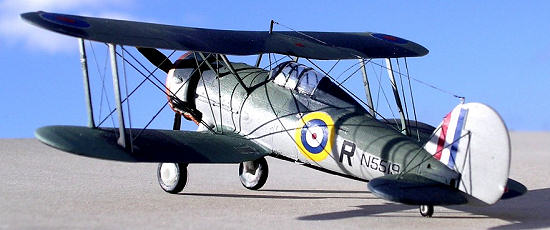 loan of 6 Sea Gladiators.
These biplanes were assembled and wholly delivered to Hal Far along with
maintenance crew who were made up of eager British and very enthusiastic Maltese
servicemen.
loan of 6 Sea Gladiators.
These biplanes were assembled and wholly delivered to Hal Far along with
maintenance crew who were made up of eager British and very enthusiastic Maltese
servicemen.
Among the first volunteers to crew the Sea Gladiators were flight Lt.George Burges who was Air Commander Maynard’s personal aid and Sqn Ldr Alan C ‘Jock’ Martin, Flying Officer Williams J ‘Timber’ Woods and Flight Lt Peter G Keeble. More aircrew from No3 A & CU also volunteered. Of these only Flg.Off Waters had flown Sea Gladiators when he spent a week on HMS Glorious flying training with Sq 802. There was a period when orders for loan of aircraft was reversed and be crated and transported tom Egypt instead but counter orders resulted that a fighter Flight Unit was reformed with Sea Gladiators N5519, N5520 and N5531. These Gladiators received minor modifications including addition of armor plating as cockpit bulkhead for pilot protection. These were furnished by HM Malta Dockyard at Cospicua. To compensate for additional weight items like the arrestor hook gear and dinghy components were removed.
The flight operated on a shift system consisting of two flights with three pilots each. This in turn meant that any two Sea Gladiators were airborne at any one time while another was left in reserve in the event that either one of the operational two become unserviceable .The other Sea Gladiator stored for spares.
Tuesday 11th June 1940 was the very first air bombardment of the war over the Mediterranean and this took place right over Malta. No one at that point in time could think what the Luftwaffe and Regia Aeronautica had in mind in trying to blast the island of Malta into oblivion with daily bombing raids and badly outnumbered RAF pilots were to fight so honorably. My father recalls the first air raid event so vividly. He used to work at John Bull Ironmongery stores at St.John’s Square right in the middle of the town of Valletta. On that day the shop had to close early after the first bombing because there were rumors that more bombing of the port area in the Grand Harbour was to take place on that day. Other places that took the brand of the first bombing were the town of Marsa which is in the inlet port area where fuel and all sort of supplies were stowed; the airfield at Hal Far and the Kalafrana seaplane base further south of the island. These areas were all strategic military positions prone to attack.
Several formations of five SM79s attacked in just as many
waves. Two Sea Gladiators took off from Hal Far airfield to intercept 18 Macchi
C200 Saetta fighters that kept escorting the bombers. Both Sq Ldr Martin and Flt
Lt Burges reported making fleeting passes at the formation of enemy aircraft
without yielding any results in spite of their gallant effort. They discovered
that the SM79 with its three motors was faster than the Sea Gladiator in level
flight. During the afternoon attack, Flg Officer Woods planned to exceed the
height of the enemy formation and by gaining this altitude he could match the
speed of the faster SM79 by diving above them. He attacked two sections of 5
SM79 without success and while climbing for more height he was pounced by an
 enemy fighter. During the subsequent three minutes dogfight, Woods got the enemy
fighter a good burst; full deflection shot and the Macchi C200 started to emit
smoke and just made it back to base in Sicily on almost dry fuel tanks.
enemy fighter. During the subsequent three minutes dogfight, Woods got the enemy
fighter a good burst; full deflection shot and the Macchi C200 started to emit
smoke and just made it back to base in Sicily on almost dry fuel tanks.
This was followed by a lull in the bombing for the rest of the day when Benito Mussolini decided that the primary objective at the time was France and other territory it was still occupying in Africa. On the 12th of June Italy returned with her attacks on the island with SM79 and escort fighters at high altitude. Late that evening Berlin radio announced that the Regia Aeronautica had succeeded in destroying port installations and that Britain’s naval base in Malta was put out of action. To verify the report a lone SM79 was dispatched on the next evening on recce sortie of the island. Two Sea Gladiators scrambled to intercept the intruding SM79 and climbed to 14,000 feet. The enemy aircraft was flying 3,000 feet below their height. As it headed from the south of the island towards Valletta the two Sea Gladiators took their turn in making strafing passes and as the bombers passed over the Marsa, Valletta area towards Sliema the SM79 burst into flames and went down in a ball of fire in the sea off Sliema. Two of the crew of 6 managed to bale out and wee picked from the sea close by, just off the Grand Harbour, and were the first POWs in the war. The next Burges flying N5519 achieved success of similar importance was when it entered into a dogfight with a Macchi C200. It happened that the slower Gladiator gave burst at the C200 as it overshot it and that was when the C200 caught fire and the pilot baled out.
There were more encounters, this time with CR-42s in the days that followed and on the 19th of July, Burges had the distinction of being the first Malta pilot to receive the DFC with the award being published in the London Gazette of 19th July for shooting down three enemy aircraft and damaging three more. On the 31st of July a lone SM79 flew over the island on a recce sortie with an escort of 12 CR42s. In the ensuing engagement Gladiator N5519 was pounced by the enemy fighters and shot down. The pilot Flying Officer Hartley managed to bale out and suffered burns that although survived his flying days in Malta were over.
There were many action stories that took place in the months that followed that were proof that the outnumbered RAF pilots were fighting honorably. On the 25th of September three Hurricane and two Sea Gladiators were scrambled to counter an incoming raid of nine Macchi C200, and on 2nd November Burges in N5520 in company of two Hurricanes attacked a formation of 20 SM79s escorted by eleven Macchi C200. Burges attacked the formation which he identified as CR42s and shot one of these down but he did not see it crash, he also claimed a second damaged,. By the end of December 1940 four Sea Gladiators were still as being on strength of 261 Sq. As the war went on there were more encounters and on the 24th of January 1941 Sub Lt.Sewell was up in a Sea Gladiator (now with 806 Sq) on a meteorological flight when he noticed a string of tracers passing his starboard wings, followed a moment later by a Junkers Ju88 diving towards Hal Far airfield. Seawell followed the intruder and reportedly shot it down off the coast. Next day a scramble from Hal far was recorded, two Fulmars and three Sea Gladiators going up but no contact with the enemy resulted. The story goes on and on with more encounters and enemy aircraft shot down and others damaged.
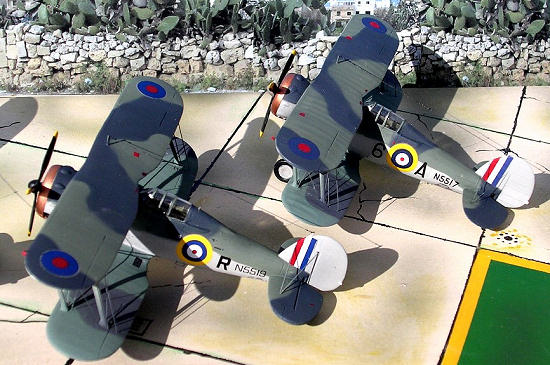 As far as can be determined, Malta’s Sea Gladiators claimed
at least nine enemy air combat victories with at least another five enemy
aircraft damaged. Of these claims three and possibly four were claimed by pilots
flying N5520. On the 15th of April 1942 the Maltese were honored by
King George VI with the award of the George Cross and because of persistent
enemy activity the presentation could not take place then but was held on the 13th
September 1942 when Lord Gort VC presented the Cross and the King’s letter to
Chief Justice Sir George Borg who received them on behalf of the People of
Malta. A year later another ceremony took place once more on Palace Square,
Valletta when the sole surviving Gladiator N5520 ‘FAITH’ was presented by Air
Vice Marshal Sir Keith Park on behalf of the RAF to Chief Justice Sir George
Borg who again received it on behalf of the People of Malta. Today the Sea
Gladiator Faith is the main exhibit at the National War Museum in Valetta. It is
hoped that in the near future this important Great War survivor will be given a
full refurbishment and be relocated at the ever-growing Malta Aviation Museum
located at ta’Qali. Ta’Qali is a disused airfield these days and has turned into
a national park. Being an important WWII airfield the place itself has a long
history with a long list of fighter and bomber aircraft that operated from it.
As far as can be determined, Malta’s Sea Gladiators claimed
at least nine enemy air combat victories with at least another five enemy
aircraft damaged. Of these claims three and possibly four were claimed by pilots
flying N5520. On the 15th of April 1942 the Maltese were honored by
King George VI with the award of the George Cross and because of persistent
enemy activity the presentation could not take place then but was held on the 13th
September 1942 when Lord Gort VC presented the Cross and the King’s letter to
Chief Justice Sir George Borg who received them on behalf of the People of
Malta. A year later another ceremony took place once more on Palace Square,
Valletta when the sole surviving Gladiator N5520 ‘FAITH’ was presented by Air
Vice Marshal Sir Keith Park on behalf of the RAF to Chief Justice Sir George
Borg who again received it on behalf of the People of Malta. Today the Sea
Gladiator Faith is the main exhibit at the National War Museum in Valetta. It is
hoped that in the near future this important Great War survivor will be given a
full refurbishment and be relocated at the ever-growing Malta Aviation Museum
located at ta’Qali. Ta’Qali is a disused airfield these days and has turned into
a national park. Being an important WWII airfield the place itself has a long
history with a long list of fighter and bomber aircraft that operated from it.
| THE KIT |
The 1/72 scale model of the Sea Gladiator comes in the usual open ended Pavla Style of boxing with a difference that the two outside covers have side view drawings of all colour scheme decal options instead of showing these on one cover only. My fancy fell on Sea Gladiator N5519, as it is the one remembered for its role in the early stages of the air war in the defense of Malta. Sea Gladiator N5519/R was based at Hal Far airfield in Malta June 1940. Flying on N5519, Fl/Lt George Burges shot down a Savoia Marchetti SM79 and a Macchi C200 Saetta the next day.
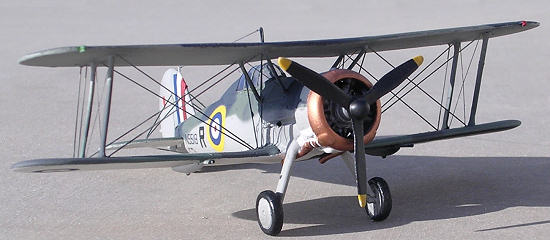 The current Pavla boxing correctly describes it as a
camouflaged Sea Gladiator, 3-prop version in FAA camouflage but reference books
also show same aircraft in an overall aluminium finish with a yellow band across
the rear fuselage when it was still attached to HMS Glorious some time before
the war.
The current Pavla boxing correctly describes it as a
camouflaged Sea Gladiator, 3-prop version in FAA camouflage but reference books
also show same aircraft in an overall aluminium finish with a yellow band across
the rear fuselage when it was still attached to HMS Glorious some time before
the war.
The Pavla kit of the Sea Gladiator is rather nice with provision of arrestor hook and three bladed prop, a welcome from the usual two bladed type found in various previous releases by other kit suppliers. In common with most short run kits there are no locating pins and the sprue gates are on the thick side and requires care in parting them. This is not a big deal and parting them with a fine hacksaw blade will prevent any damage. Otherwise the moulded parts clean up nicely and these contain fine engraved paneling and other surface detailing. There are two cockpit canopies, vacform type and look very accurate and clear. At a first glance I thought that these were identical type which is a normal feature in Pavla kits to have a spare item of this sort but on closer examination of both the instruction sheet and the cockpit canopy themselves these showed a slight variation which made a difference why one type was to fit a particular Sea Gladiator and not the other because it contained Armour wind screen with more stiffened front construction. If one chooses to do the 2-blade prop version that is a one-piece prop complete with spinner, there is a sink hole at the side of the spinner that needs to be addressed with a tiny amount of putty and reshaped prior to use. The three blade prop is slightly too flat and maybe not quite convincing but upon rechecking it was just the sort of three bladed prop that was attached to the aircraft type and some reshaping of the blade trailing edge thickness will save the day.
| CONSTRUCTION |
Full interior fine detail is provided in form of cream coloured resin parts. These include an accurate instrument panel with respect to gauges, detail cockpit floor, a lightweight seat, which has integrally moulded seat belt, and there is forward and rear plating to cockpit. Consider such a small scale, the components are so intricate and superb in detail especially if the side cockpit panel/door, which comes as a separate item, is left open along with the hood, which is also suggested in the instructions. However I found that the cockpit floor is a little too wide and some 1mm needs to be removed with a file in order to fit properly. Also I could find no indication where to place parts R18 and R19 though I could assume that these would probably fit on the insides of cockpit. The interiors are first painted in interior green and then fitted to one side of fuselage, then put the other half together. The kit includes optional parts to model any choice of two Sea Gladiators N5519 and N5567 or any two Gladiators N5585 and L8011, which are a Mk2 and a Mk1 respectively and are in dark earth and green camouflage and another Gladiator K8027 in metal finish and 87 Sq markings. This means there are markings for five different aircraft liveries.
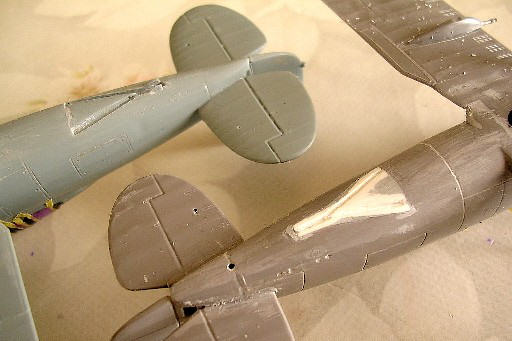 At the stage when it comes
to fit the lower wing to fuselage care is needed as there are slight differences
of wing to fuselage levels and some filing may need to be done to achieve a
smooth continuous joint. These are left aside for a few hours until everything
has set solid. One other comment is that the tailplanes are on the thick size in
section and thinning them by scraping or filing will spoil the otherwise fine
fabric texture. As explained earlier the Malta based version although had the
accessories for carrying an arrestor hook, this in fact was dismounted in order
to save weight and therefore was left without it. If one elects to fit the other
Sea Gladiator N5567, then the arrestor hook should be in place. Alternative part
with a faired over rear fuselage is also provided if a Gladiator is planned to
be built. The rest of the kit went without a hitch but be warned this is a
biplane and care is always needed when aligning the fuselage struts in
particular. When the upper wings are lowered and attached to the struts again
these are given good time to set as the kit will have to be subjected to some
delicate handling when drilling holes in preparation for rigging which lie close
to each strut root. For rigging I used thin nylon tread and this gave the kit
more strength when it was stretched in place and secured with tiny drops of
super glue. Kit was then sanded and excess nylon thread removed and area
smoothened. This is a slow process but a fine pleasing model will result in the
end.
At the stage when it comes
to fit the lower wing to fuselage care is needed as there are slight differences
of wing to fuselage levels and some filing may need to be done to achieve a
smooth continuous joint. These are left aside for a few hours until everything
has set solid. One other comment is that the tailplanes are on the thick size in
section and thinning them by scraping or filing will spoil the otherwise fine
fabric texture. As explained earlier the Malta based version although had the
accessories for carrying an arrestor hook, this in fact was dismounted in order
to save weight and therefore was left without it. If one elects to fit the other
Sea Gladiator N5567, then the arrestor hook should be in place. Alternative part
with a faired over rear fuselage is also provided if a Gladiator is planned to
be built. The rest of the kit went without a hitch but be warned this is a
biplane and care is always needed when aligning the fuselage struts in
particular. When the upper wings are lowered and attached to the struts again
these are given good time to set as the kit will have to be subjected to some
delicate handling when drilling holes in preparation for rigging which lie close
to each strut root. For rigging I used thin nylon tread and this gave the kit
more strength when it was stretched in place and secured with tiny drops of
super glue. Kit was then sanded and excess nylon thread removed and area
smoothened. This is a slow process but a fine pleasing model will result in the
end.
| COLORS & MARKINGS |
The Sea Gladiator first had
the lower wing and lower fuselage painted in white and black as shown in the
instruction. These areas were then masked and the sea grey lower surfaces and u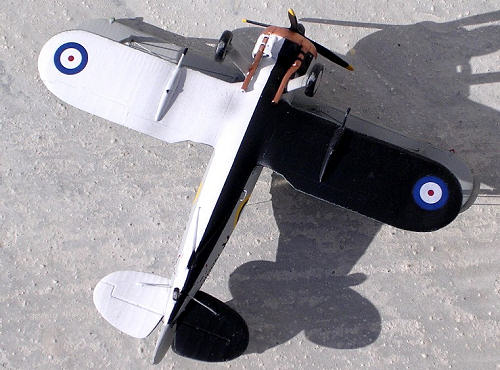 nderneath
the upper wing were then airbrushed and allowed to dry thoroughly. These areas
were again masked with tape and sequence of applying the light slate grey to
lower wing and dark slate grey to upper wing and fuselage followed and finally
applying disruptive and feathered extra dark sea grey in appropriate places.
With masking removed and little adjustment and touching up made to the otherwise
completed model, the wheels and props and front of cowling were painted
accordingly and finally the kit was given a coat of Lieu liquid polish. Decals
are beautifully printed and in correct register. These were applied to their
proper spots and in the end the kit was given a coat of semi matt varnish.
nderneath
the upper wing were then airbrushed and allowed to dry thoroughly. These areas
were again masked with tape and sequence of applying the light slate grey to
lower wing and dark slate grey to upper wing and fuselage followed and finally
applying disruptive and feathered extra dark sea grey in appropriate places.
With masking removed and little adjustment and touching up made to the otherwise
completed model, the wheels and props and front of cowling were painted
accordingly and finally the kit was given a coat of Lieu liquid polish. Decals
are beautifully printed and in correct register. These were applied to their
proper spots and in the end the kit was given a coat of semi matt varnish.
| CONCLUSIONS |
I enjoyed building the Pavla Sea Gladiator; so different from previous Pavla models I have made, not quite as straight forward, but the extra effort was worthwhile and definitely rewarding. The Sea Gladiator represents a defensive fighter that has a story for the defense of Malta behind it and what is better than being displayed in a showcase alongside other Malta based naval aircraft like the Skua and Fulmar.
September 2006
Copyright ModelingMadness.com
If you would like your product reviewed fairly and fairly quickly, pleasecontact the editor or see other details in the Note to Contributors.